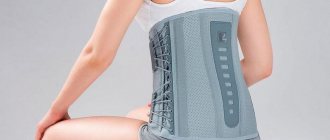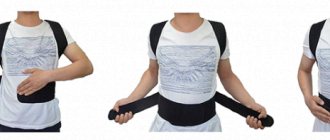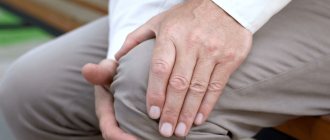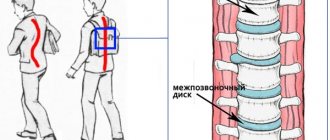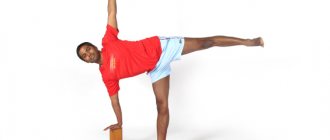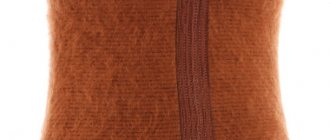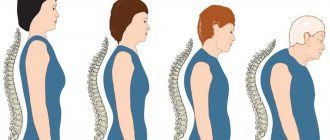The issue of choosing an orthopedic corset must be approached with maximum responsibility. Otherwise, existing problems with the spine may worsen. The degree of its impact on the condition of the lumbosacral spine largely depends on the correct selection of an orthopedic product. When purchasing a corset, you need to focus on such parameters as the type, size and degree of rigidity of the device.
Hardness degree
The degree of rigidity of the orthopedic corset is selected depending on the severity of the problem with the lumbar region. If a person’s mobility is severely limited and he cannot straighten up from pain, it is recommended to wear a rigid corset. This device is also used after surgery on the spine.
A rigid corset can be worn during rehabilitation after a fracture. Its use is indicated for lumbago and intervertebral hernia. For these diseases, strong fixation of the spinal column is necessary.
What kind of corset is needed for a hernia or a spinal fracture?
A lumbar hernia occurs when the centers of the discs are displaced and protrude through defects in the outer layer of the spinal column. The nerve passing through the spinal canal is pinched, causing severe pain, weakness and numbness of the lower extremities. A feature of orthopedic products is the transfer of pressure from the lower back to the peritoneal area. This relief relieves pain and promotes recovery.
What kind of corset is needed for a compression fracture of the spine? This type of injury is quite common. It is called a compression fracture because the vertebrae are damaged due to strong compression or bending, for example, due to jumping on straight legs or falling on the tailbone. One of the reasons is also weakness of bone tissue. The corset device keeps the spine motionless and relieves stress.
Orthopedic product size
The choice of a semi-rigid orthopedic corset should take into account the anatomical features of the figure. The size range of products manufactured by different manufacturers may vary significantly.
When choosing a corset, you most often need to focus on waist size. But there are also orthopedic products, the size of which is determined by the circumference of the back.
When measuring your waist, the measuring tape should fit as closely as possible to your body. It should not be loosened or tightened too much.
How to choose a corset for the lumbar spine?
The design of this product provides full coverage of the lower back, upper pelvis and lower chest. When choosing, the following factors are taken into account:
- rigidity;
- model;
- size.
In the first case, they mean the degree of fixation. For preventive purposes and reducing the degree of physical activity, more elastic options are used. During the rehabilitation period, the structure must be reinforced with stiffeners.
As for the size, the choice depends on the circumference of the waist and lower back. Each manufacturer offers its own standard sizes and procedure for taking measurements. This information is contained in the instructions.
Corset fit
The lower edge of the product should hug the upper part of the pelvis. In this case, the top layer of the corset fits tightly to the lower back.
Important! Women with a pronounced waist need to use special orthopedic corsets, which are designed specifically for the fair sex.
It is recommended to wear the corset over underwear and not over the naked body. This will help avoid friction.
After wearing a neoprene corset in the hot season, the lower back is wiped dry after using the product. This helps prevent you from catching a cold and aggravating your back problems.
In conclusion, it should be noted that it is recommended to wash the orthopedic corset on a delicate cycle. In this case, the product must be fastened with all hooks. You can additionally use a special laundry bag. When caring for an orthopedic product, follow the appropriate instructions indicated on the packaging.
Medical back corset - what is it and why is it needed?
This article explains what a medical corset is, why it is needed, and provides answers to common questions:
What is a corset for?
- Types of corsets
- Purpose of corsets
- Location on the spine
- Rigidity
How to wear a corset?
Throughout history, people have been concerned about their health. After all, health is life. Today, one of the most common diseases are diseases of the back and spine. The causes of such disorders are a sedentary lifestyle, lack of physical activity, poor posture and excess weight. However, many spinal problems can be solved without resorting to complex procedures and lengthy treatment. And special orthopedic back corsets can help with this.
What is a corset for?
Initially, the corset was an item of women's clothing and was intended to create a beautiful silhouette. Today this product is produced for all age categories, has the function of a corrector and fixator and is prescribed in the following situations:
- curvature of the spine;
- pathologies of the spinal column;
- osteochondrosis;
- intervertebral hernia;
- pinched nerves;
- increased physical stress on the back;
- post-traumatic and postoperative recovery;
- playing sports.
Types of corsets
Products can be classified according to the following parameters:
- material – textile, leather, composite, polymer, metal-polymer materials, with or without filling;
- adjustment - corsets with the ability to adjust sizes to fit the figure (with belts, Velcro, elastic bands) or without it (made to individual measurements);
- appointment;
- location on the spine;
- rigidity.
Purpose of corsets
Based on their functionality, medical corsets can be divided into three types.
Corsets-fixators. Their purpose is to support and secure the spine in the correct position. Such products with rigid inserts are used for injuries, spinal diseases, hernias, as well as for the prevention of postural disorders, especially in children.
Corrective. Worn to correct postural deviations (lordosis, kyphosis, scoliosis). They have a rigid shape and are made from individual casts of the patient’s back.
Support corsets. The purpose of such products is to maintain the correct position of the spine and protect against overload. Indispensable in sports, dancing, in conditions of heavy physical labor and as support for a weakened back.
Location on the spine
As you know, the spinal column has four sections: cervical, thoracic, lumbar, sacral. Each department has its own types of orthopedic products. Depending on the severity of the disease, such corsets can be soft or hard and have distinctive design features.
One of the types of corset is a lumbar bandage. This modification is mainly used by pregnant women to make walking easier and prevent lower back pain.
Corset rigidity
According to the degree of rigidity of the structure, we can distinguish soft, rigid and semi-rigid corsets.
For the treatment of diseases of the spinal column, the use of rigid corsets is prescribed. However, you should know that in order to avoid atrophy of the back muscles, you can wear such products for several hours a day and only after visiting a specialist.
Soft corsets have a preventive function. The design, made of elastic and dense non-stretchable materials, allows you to gently fix the spine and maintain it in a physiologically correct position.
The most commonly used corsets are those with a semi-rigid frame. They are versatile, comfortable and do not restrict movement, provide good back support and are therapeutic.
How to wear a corset?
All experts unanimously say: in order for the use of an orthopedic corset to have a positive effect, you should remember several important rules:
— the product should be put on in a supine position and best in the morning;
— the corset should be comfortable, not squeeze the body, but also not be too loose;
— the maximum time for using the corset is 6 hours, after which you should definitely take a break;
- Under no circumstances should the product be used for any damage to the skin.
— for reasons of hygiene, you should not wear a corset on a naked body, you must use thin underwear made from natural fabrics.
The use of medical corsets brings significant positive effects.
But before purchasing a remedy, you must undergo a full examination and consult with an orthopedic doctor. It is important to remember that spine treatment will be successful and effective if you use a corset in combination with other methods. Author: K.M.N., Academician of the Russian Academy of Medical Sciences M.A. Bobyr
Purpose
Often a corset for the lumbosacral spine is prescribed in the postoperative period or for injuries. After removing hernias, it is simply irreplaceable. Relieve pain, stabilize the spine, relax excessively tense muscles; all this can be easily handled by a properly selected corset. Manufacturers of orthopedic products make many models for completely different situations. Therefore, choosing the right one for you will not be difficult. A semi-rigid or rigid lumbosacral corset can be purchased at any specialized store. Before purchasing, you just need to coordinate your actions with your doctor, who, depending on your specific case, will advise the correct option. For example, a rigid lumbosacral orthopedic corset is prescribed for radiculitis, osteochondrosis, spondylosis, scoliosis, hernias and injuries.
You need to know that wearing a corset will not ensure your recovery; you must comply with all the doctor’s requests and do the prescribed set of exercises. So, please note that this group of products cannot be worn around the clock. It is imperative to take breaks, otherwise your muscles will simply refuse to perform their functions and atrophy.
The corsets for the lumbosacral and thoracic spine presented in our store are some of the best in their segment. They are made from high quality materials, carefully packed by our workers in the warehouse and immediately sent to the customer after order confirmation. The low price is ensured by long-term direct cooperation with suppliers - leading manufacturers of orthopedic products. If you want to take advantage of all the benefits of our store, you can place an order online and our specialists will contact you.
How to wear a posture corrector?
Orthopedists recommend wearing the corrector on a cotton T-shirt while standing. First, the arms are pulled through the elastic loops in the same way as putting on a backpack. On the back, the straps cross and separate the shoulders. The straps pass in the armpit area. The corrector is secured to the waist or belt (depending on the design) using fasteners or Velcro.
You need to make sure that when fixing the posture corrector, the tapes do not twist. The degree of belt tension is increased gradually. The tightness of the fit is adjusted using fasteners. To see how much the tension has changed while wearing the orthopedic corrector, marks are made on the belts.
The posture corrector begins to be worn for 30 minutes a day, gradually increasing the duration at the end of the first week to 2 hours. During the second week, the duration of wearing is increased to 3 hours. And so with each subsequent week the duration should increase by exactly 1 hour. If you follow the calculations exactly, by the end of the 5th week and over the next 11 weeks you need to be in a corset for up to 6 hours a day. After this, the countdown begins: the correction time is reduced by an hour every 10 days. When they reach 2 hours a day, stop wearing the posture corrector. The total duration of correction is on average 160 days.
The posture corrector is designed to be worn when a person is in a passive state. For example, while watching TV, reading a book. To ensure muscle relaxation, the reclinator is removed at night.
With a mild form of stoop, it is possible to achieve the correct rotation of the shoulders with the help of a posture corrector within 4 weeks. But it will take about 4 more months to consolidate the results obtained.
Criteria for ensuring that the posture corrector is worn correctly:
- shoulders open;
- shoulder blades retracted;
- straight back with an S-shaped curve;
- straightened chest.
If you lean your back against a wall with a correctly worn orthopedic device for posture correction, the back of your head, shoulder blades, and buttocks should touch the wall.

